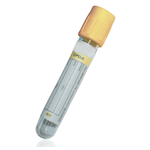Suitable Specimen Types
- Serum
- EDTA Plasma
- Li Hep Plasma
Sample Processing in Laboratory
Usual
Sample Preparation
Centrifuge
Turnaround Time
1 daySample Stability
Samples are stable for seven days when stored at 4 ºC, or can be kept indefinitely if stored at -20 ºC.
Creatinine
General Information
Creatinine is a non-protein waste product of creatine phosphate metabolism by skeletal muscle tissue. Creatinine production is continuous and is proportional to muscle mass. The measurement is used in the estimation of glomerular filtration rate which is a sensitive indicator of chronic kidney disease. Circulating concentration will relate to the muscle mass of the individual, the volume of distribution of the creatinine, and the glomerular filtration rate (GFR). It follows that concentrations will be higher in men than women who have the same GFR as males have a larger muscle mass. It also follows that some ethnic groups will have higher or lower creatines depending on the average muscle mass within the population.
Serum creatinine concentrations are used in the determination of creatinine clearance (an indicator of GFR) and estimation of the GFR utilising the 4 variable MDRD equation. Each of these derived figures can then be used to both identify and monitor chronic kidney disease. Estimation of GFR by formula is now recommended by the Department of Health in support of the Renal National Service Frame work. Creatinine clearance requires measurement of creatinine in serum and in urine.
Patient Preparation
None
Notes
No significant interference from haemolysis, icterus or lipaemia.
Reference Range
Serum creatinine:
64 - 104 µmol/L (Male)
49 - 90 µmol/L (Female)
(Source : Abbott Diagnostics)
Laboratory practice is that eGFR using the 4 variable MDRD equation is applied to males with a creatinine of >111 µmol/L and females with a creatinine >98 µmol/L.
As individuals age they usually lose muscle mass which means that if their renal function remains unaffected creatine concentration in serum should fall as we age. Conventional population based reference intervals have not usually been age stratified. The impact of this is that individuals can have creatinine concentrations within the conventional population reference range while having significant renal impairment.
Note
From Monday 10th September 2018 creatinine will be measured using the enzymatic creatinine method.
For further information on how this will effect your results please refer to:
http://www.heftpathology.com/alphaindex/downloads/n.html
Enzymatic creatinine is currently not a UKAS accredited test. It will be assessed in October 2018.
Source of Reference Range
Abbott DiagnosticsSpecifications
- EQA Scheme?: Yes
-
EQA Status:
NEQAS for Clinical Chemistry
